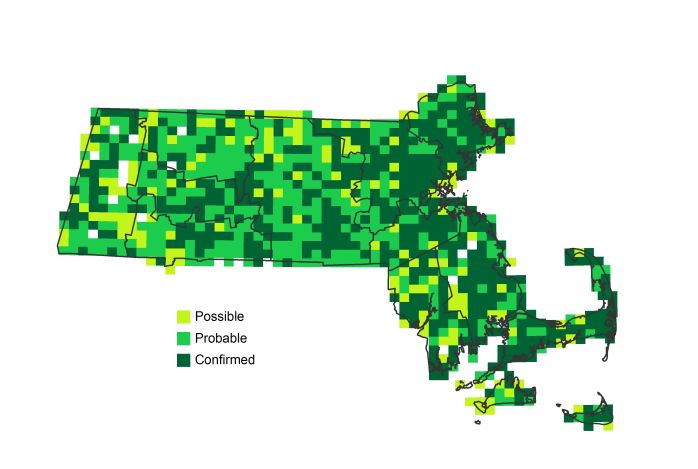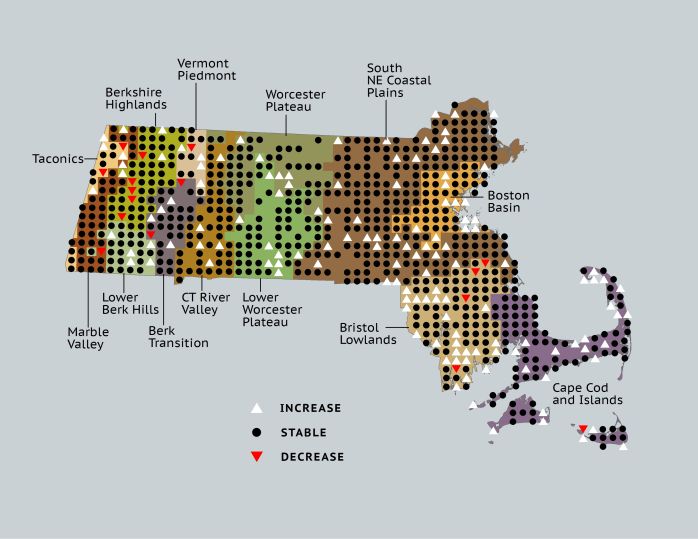Find a Bird
Brown-headed Cowbird
Molothrus ater

Nearly ubiquitous and likely increasing
“This contemptible bird every child should know if for no better reason than to despise it.” – Neltje Blanchan, Birds That Every Child Should Know
The Brown-headed Cowbird, so named because of its strong tendency to follow grazing animals and feed upon the insects they disturb, has a less-than-sterling reputation, although it presents one of the most interesting life-history characters of any species in North America. The Brown-headed Cowbird is a brood parasite. Alone among Massachusetts’ breeding birds, the Brown-headed Cowbird never builds a nest and never raises its own young, trusting them instead to the care of dozens of different foster species. This tactic has served the cowbirds well, and also makes them an interesting species to track with Breeding Bird Atlas data.
Historic Status
Moving east as European settlement began moving west, Brown-headed Cowbirds, or “Cow Blackbirds,” as they were known during much of the nineteenth century, were already a fixture in Massachusetts by the 1830s. Even at that time they were known for their lack of “philoprogenitiveness,” according to an 1839 report to the state legislature on the birds in the Bay State (Peabody 1839). The species’ brood parasitism, though, is only a moral flaw in the eyes of humanity, and not an economic issue. As such, the birds were rarely the target of farmers’ muskets. Forbush pointed out that when flocked together, they can form “a wandering, unattached light infantry of insect destroyers” (Forbush, 1908). Despite the fact that they arrived in Massachusetts opportunistically to take advantage of newly emerging farmland habitat, the eventual diminishment of this habitat has not deterred the cowbird, since it has adapted to lay its eggs in the nests of more than 200 species of birds. Instead of regressing to its historic distribution range like the Dickcissel, the Cowbird instead spread across the entirety of the United States during the twentieth century.
Atlas 1 Distribution
Brown-headed Cowbirds ranged from being ubiquitous to merely widespread in all corners of the state during Atlas 1, and overall they came in with 77% block occupancy. The birds were not missing from any more than 5 or 6 blocks in any ecoregion west of the Connecticut River Valley; in the Marble Valleys, they were found in every block but one. The Connecticut River Valley had a slightly lower density, and the Worcester and Lower Worcester Plateaus hovered at around 75% block occupancy, likely due to the higher ratio of forested land to active agriculture in these areas. The Coastal Plains’ matrix of forest and suburban habitat was well populated by cowbirds, but the more highly developed Boston Basin had less than 70% block occupancy. The Bristol/Narragansett Lowlands were also less populated than the Coastal Plains, and Cape Cod and the Islands reported only 63% of its blocks with breeding cowbirds.
Atlas 2 Distribution and Change
The Brown-headed Cowbird has demonstrated that, despite estimations of loss in states other than Massachusetts (McGowan & Corwin 2008), their breeding footprint in the Commonwealth is still increasing. In Atlas 2 they increased to 94% block occupancy, a notable net gain over Atlas 1. Their Bay State distribution is “bookended” by their lowest regional block occupancy – below 90% in both the far western Taconics and on Cape Cod. Aside from this trend, they do not seem to show a regional preference. From the Worcester Plateau eastward, newly occupied blocks far outpace losses, indicating a growth of cowbirds in the eastern regions.
Atlas 1 Map

Atlas 2 Map

Atlas Change Map

Ecoregion Data
Atlas 1 | Atlas 2 | Change | ||||||
Ecoregion | # Blocks | % Blocks | % of Range | # Blocks | % Blocks | % of Range | Change in # Blocks | Change in % Blocks |
Taconic Mountains | 11 | 68.8 | 1.5 | 19 | 76.0 | 2.0 | 2 | 13.3 |
Marble Valleys/Housatonic Valley | 38 | 97.4 | 5.1 | 38 | 97.4 | 3.9 | 0 | 0.0 |
Berkshire Highlands | 49 | 89.1 | 6.6 | 50 | 90.9 | 5.1 | 0 | 0.0 |
Lower Berkshire Hills | 23 | 82.1 | 3.1 | 28 | 90.3 | 2.9 | 5 | 18.5 |
Vermont Piedmont | 12 | 70.6 | 1.6 | 16 | 94.1 | 1.6 | 2 | 16.7 |
Berkshire Transition | 33 | 86.8 | 4.4 | 38 | 95.0 | 3.9 | 2 | 6.5 |
Connecticut River Valley | 47 | 83.9 | 6.3 | 63 | 96.9 | 6.5 | 5 | 10.4 |
Worcester Plateau | 60 | 76.9 | 8.0 | 87 | 98.9 | 8.9 | 8 | 16.7 |
Lower Worcester Plateau | 56 | 75.7 | 7.5 | 78 | 97.5 | 8.0 | 8 | 14.8 |
S. New England Coastal Plains and Hills | 216 | 80.0 | 29.0 | 279 | 98.6 | 28.7 | 32 | 14.2 |
Boston Basin | 39 | 69.6 | 5.2 | 52 | 92.9 | 5.3 | 12 | 21.8 |
Bristol and Narragansett Lowlands | 76 | 71.7 | 10.2 | 104 | 91.2 | 10.7 | 21 | 20.8 |
Cape Cod and Islands | 86 | 63.2 | 11.5 | 121 | 84.0 | 12.4 | 24 | 20.0 |
Statewide Total | 746 | 77.0 | 100.0 | 973 | 93.8 | 100.0 | 121 | 14.6 |
Notes
The Brown-headed Cowbird shows a significant decreasing Breeding Bird Survey trend in the Eastern US overall.



